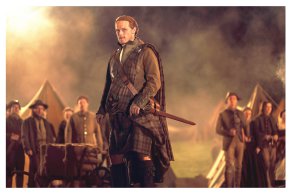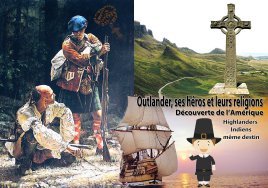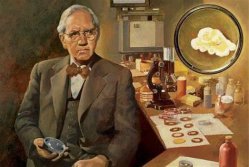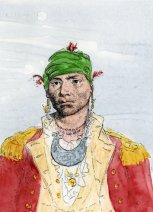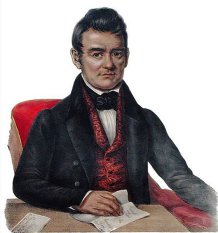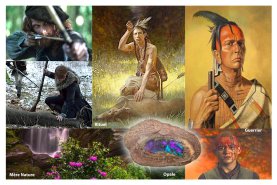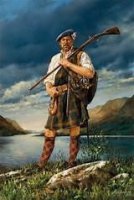Outlander, ses héros
et leurs religions
Highlanders et Indiens, un destin commun
« Ils ne peuvent pas être des ennemis puisqu’ils sont comme nous, ce sont des chasseurs et des montagnards, pourquoi ne verraient-ils pas ce que nous voyons ?»
Jamie dans le Tome 5.
Ces sociétés ancestrales, très bien organisées, sont deux cultures géographiquement tellement éloignées et pourtant, c’est le mauvais sort de l’histoire de l’une et l’autre qui va les rapprocher.
De part et d’autre de l’Océan, à première vue, nous découvrons deux peuples de fabuleux guerriers vêtus de la manière que nous pourrions qualifier de folklorique.
Ils ont un laird ou un chef qu’ils respectent, honorent et écoutent.
Kilt, tartan pour les uns ; plumes et peintures de guerre pour les autres.
Ils vivent en clan ou en tribu. La terre est un bien commun et tous en font partie
Ils ont des traditions, des rituels (1), des mœurs très semblables. Voici quelques exemples parmi tant d’autres.
Le mariage :
Les Kahnuen’kehakas (Iroquois) ont une conception du mariage qui ressemble aux traditions dans les Highlands :
• Pour les Iroquois, ce sont les parents qui organisent tout en fonction des affinités observées lorsqu’ils étaient enfants. Ils ne peuvent pas épouser quelqu’un appartenant à certaines autres tribus.
• Dans les Highlands, on se marie à l’intérieur du même clan sauf pour former des alliances.
Justice et cruauté
• Les Iroquois torturent et brûlent vifs leurs ennemis...
• « Jacob le Rouge » Chef du clan Mackenzie a la réputation d’avoir été très cruel envers ses ennemis. (torture et justice expéditive)
Ils ont un artisanat élaboré : tissus, bijoux…
Voici une phrase qui se fait l’écho de nos découvertes après avoir lu le Chemin des Larmes vécu par le peuple des Cherokees.
Et ce magnifique tableau de Robert Griffing a éveillé en nous bien des curiosités.
Nous avons donc trouvé quelques réponses…
Vous en trouverez sans aucun doute d’autres.
Nous voici donc sur la piste des Highlanders et de leurs cousins indiens : deux peuples de montagnards.
La préparation au combat avait sa propre coutume dans les
Highlands. La danse de l'épée.
Robert Griffing montre un soldat du 42e régiment des Highlands dans les murs de Fort Ticonderoga. Selon la tradition du clan, si un danseur touchait les épées sous ses pieds pendant la danse, cela annoncerait la fin de la bataille. Un joueur de cornemuse fournit la musique. Un guerrier iroquois regarde, attendant les résultats.
Un sourire amusé et approbateur est sur le visage d'un chef de tribu alors qu'il marque le temps avec son tambour.
Les Indiens avaient leurs peintures de guerre, chants et danses….
Ils ont des légendes ancestrales et des croyances païennes.
Les deux peuples entretiennent les mêmes superstitions (2)…
Les Ecossais jouent au Shinty.
Les Indiens jouent au jeu de Lacrosse entre villages.
Mais ils règlent également leurs différents avec ce jeu.
Et nous pouvons aller plus loin dans la comparaison.
Leur histoire a bien d’autres points communs historiquement.
Les autorités anglaises ont toujours négocié avec les Amérindiens leur assistance militaire.
Et si les Anglais ont connu un certain succès, c’est en partie en raison de la présence des Highlanders que les Indiens considéraient comme leurs semblables en qui ils se retrouvaient.
Highlanders et Indiens ont subi le dictat des Anglais et des Américains.
Ils vont vivre l’acharnement à détruire leur culture.
Interdiction du tartan… Européanisation des Indiens…
Spoliation….Génocide…. Racisme …. Déportation… des mots qui résonnent dans leur histoire.
Tandis que les Cherokees vivaient la Piste des Larmes, de nombreux Highlanders vivaient les Highlands Clearances et furent expulsés de leur pays d'origine pour que les propriétaires anglais puissent élever des moutons. Ils ont émigré vers le Nouveau Monde en Caroline du Nord et se sont étroitement associés à la culture amérindienne. Certains se sont mariés dans des tribus locales.
La fameuse loi du matriarcat octroya l’appartenance à la tribu aux enfants nés d’une mère Cherokee.
Alexander MacGillivray, chef avisé du XVIIIe siècle, était l'un d’eux.
Sa mère était une princesse Creek, tandis que son père venait de l'Écosse.
En 1790, il dirigea une députation de 28 chefs à New York où ils signèrent, avec le président George Washington, un traité qui céda aux Indiens tous les territoires disputés.
John Ross, (1790-1866), le chef héroïque lors de la longue marche sur la Piste des Larmes, et dont nous avons déjà parlé dans le dossier consacré aux Indiens de Caroline du Nord, avait un père Highlander et une mère Cherokee.
Texte : Françoise Rochet
Illustration : Gratianne Garcia
Les liens culturels entre les Ecossais et les Indiens d'Amérique ne se limitent pas aux événements historiques.
Il existe une énorme identité avec l'environnement et le respect de la nature.
Une autre corrélation entre les deux groupes est leur sentiment à propos de la terre.
Le concept gaélique de propriété est tout aussi fort qu'ailleurs, déclare le poète MacNeacail.
Mais la propriété n'est pas considérée comme une chose individuelle.
En gaélique, vous ne pouvez pas dire : «Je possède la terre» mais « La terre est avec moi ».
Et les Indiens disent « j’appartiens à la terre ».
MacNeacail voit aussi des similitudes entre les deux sociétés à travers leur langue qui ne fut écrite que très tardivement dans les deux cas.
Les deux langues sont riches en images à cause de la tradition orale.
Les deux nations ont fait bon usage de leur langue écrite lors de leurs combats respectifs contre les occupants. La presse, les journaux furent une arme redoutable.
Et aujourd’hui encore, Cherokees et Ecossais enseignent leur propre langue aux enfants.
Ceci nous amène à un autre point de comparaison : l’importance de l’éducation et de l’instruction des enfants.
Les Ecossais ont toujours eu à cœur de former leur jeunesse et ce, depuis la Renaissance.
Leurs universités sont réputées et ils eurent une des premières facultés de médecine à Edimbourg. Être multilingue, étudier les auteurs latins et grecs, être performant en mathématiques, tels étaient les objectifs des petits Ecossais avant l’effondrement de Culloden. Et tel, il le fut après.
La contribution des Écossais à la civilisation moderne est sans commune mesure avec la taille de leur pays : alors que l'Écosse ne représente que 10% de la population britannique, elle a vu naître plus de 20% des grands chercheurs, philosophes, ingénieurs et inventeurs de Grande-Bretagne.
On leur doit les logarithmes, la seconde loi de la thermodynamique et les lois de l'électrodynamique. Ce sont eux qui ont révolutionné la machine à vapeur, inventé le bitume, la toile imperméable, le téléphone, la télévision et le radar.
Sans parler de leur rôle de pionniers en anatomie, dans la découverte des antiseptiques et de la pénicilline.

L’histoire a retenu les frères Marconi comme les inventeurs de la télévision et pourtant, c'est bien John Logie Baird, (1888-1946) un ingénieur écossais, qui a inventé cette fameuse machine dès 1924.
En 1928, la société de Baird diffuse le premier signal de télévision transatlantique de Londres à New York, puis vers un navire. Il crée aussi la première télévision en couleur qui ne sera commercialisée qu’après sa mort
Les Écossais attribuent cet impressionnant palmarès à l'importance qu'ils accordent depuis longtemps aux études.
De même, les Cherokees se sont rendu compte de l'importance de l’éducation de leurs enfants en créant des écoles et leur objectif fut de les rouvrir après leur déportation.
C’est cette volonté qui a sauvé leur culture et qui a ouvert les portes des universités à certains d’entre eux.
Aujourd’hui, la communauté amérindienne compte des écrivains, des poètes, des artistes, des metteurs en scènes, des comédiens….
Mais aussi des scientifiques….
Un exemple parmi tant d’autre, l’opale est une pierre qui porte en elle bien des mystères. (3)
John Bennett Herrington (né en 1958 Oklahoma) est un astronaute américain et un vétéran d'une mission de la navette spatiale.
Il est le premier membre d'une tribu amérindienne (Chicacha) à avoir volé dans l'espace.
En conclusion, nous pouvons dire que la tribu et le clan étaient remarquablement similaires dans le tempérament et la philosophie et les deux cultures ont produit des combattants très habiles et courageux. Mais il avait aussi en commun l’amour et le respect de la nature.
Et puis et surtout, il y a cette force commune de caractère à affronter le destin et de renaître de ses cendres.
Ces deux deux cultures auraient pu s’effondrer définitivement sous le poids oppressant de l'expansion britannique. C’est leur énorme résilience qui les a sauvés.
Gratianne a illustré cet article et a relu Outlander pour la bonne cause.
Françoise a encore et toujours relu son Histoire avant d’écrire ce texte.
Elle remercie Gratianne pour sa patience !
Merci à Marie qui a étayé nos recherches par quelques articles…
Voici enfin une petite biographie d’un artiste qui a ravi nos yeux… et qui fait vivre les Indiens.
Il s’agit de Robert Griffing né le 9 juin 1940 à Linesville, en Pennsylvanie.
Il est passionné par l'histoire et les cultures autochtones.
Diplômé de l'Art Institute of Pittsburgh où il y a étudié l'illustration.
En 1991, après une carrière de trente ans dans la publicité, il commence à peindre les Indiens des bois de l'Est du 18e siècle.
Ses peintures se concentrent sur l'époque du chaos et de l'incertitude pour les tribus des bois alors qu'elles luttaient pour survivre à l'empiètement des Européens.
Robert Griffing espère que ses peintures mettent en évidence ce qu'il considère comme une période de l'histoire négligée.
Duane James Ray, président de la nation Seneca des Indiens, a déclaré :
«L'attention que Griffing accorde à la représentation et aux détails précis des Iroquois est remarquable et rarement vue dans le travail d'autres artistes non autochtones. Ses peintures permettent au spectateur d'avoir une compréhension particulière de la façon dont la culture iroquoise a évolué avec les influences européennes. »
John Giblin, ancien administrateur du site de Fort Pitt et Bushy Run Battlefield, déclare :
«À ma connaissance, pas une personne au cours de ce siècle n'a fait plus pour rajeunir l'intérêt pour l'histoire, l'art et la culture du début de l'ouest de la Pennsylvanie. Son travail a également donné lieu à un nouvel enthousiasme pour la mystique culturelle des Amérindiens de l'Est. »
Griffing explore également sa propre ascendance écossaise pour des idées et des sujets.
L'artiste s'est rendu en Écosse en 1996 pour rechercher sa lignée.
Un livre, The Art of Robert Griffing, avec plus de 75 planches en couleur, est une collection complète de son travail, de ses plus anciennes à ses plus récentes peintures.
Annotations :
1 Tome 4 - 5 - 6 - Exemples non exhaustifs
Parallèle des prières et de rites païens
• Danse des druidesses dans les Cromlech aux solstices, la grande prêtresse appelle le soleil entre les pierres.
• Prière apprise à Jamie par son père pour un rituel au coucher du soleil. Les Indiens ont des croyances et des couleurs spécifiques pour les points cardinaux.
• À la chasse, la prière pour éviscérer et dépecer un animal est la même.
• Respect de la nature : «Tu ne mangeras pas la chair du poisson, d’un gibier ou d’une volaille que tu n’auras pas tué de ta main. Sois reconnaissant pour celui que tu as attrapé, même si neuf autres t’ont échappé»́ dit par Jamie. (Tome 8-2)
• Animaux blancs : Dans le folklore Celte les animaux blancs étaient de bons présages.
Pour les Iroquois, ils sont des messagers. (Tome 8-1)
2 Fantomes lutins…
• Asgina ageli, est un terme Cherokee qui signifie « moitié fantôme ». Il a un pied parmi les vivants et l’autre dans le royaume des morts. Il peut parler aux esprits et voir les « Nunnahees »...le petit peuple.
• Dans les Highlands : « ce sont nos fées et nos lutins, on les appelle les « Auld Folks » explique Jamie.
Cela est raconté dans les contes Ecossais « Anciens » appelés « sidhe » en gaélique.
3 Tome 4 « Les Tambours de l’automne » :
• « On dit que les opales sont les pierres du malheur, Sassenach …»
• « Elles ne sont pas toutes maléfiques… » C’est une pierre qui absorbe les vibrations de son propriétaire, qui portera chance si elle a appartenu à quelqu’un de bien sinon ce sera du malheur.
L’opale pour les Tuscaroras :
• « Ils sont tous à la fois excités et furieux … » Ils refusent de la toucher.
• « Il existe une légende : des serpents magiques transportent des pierres dans leur tête. Si vous tuez l’un de ces serpents et lui prenez la pierre, elle vous donnera de grands pouvoirs. »
• L’opale de « Dent de Loutre » trouvée par Claire a une spirale incisée avec un « Serpent qui se mord la queue ».
L’opale dans la saga :
• Elle est importante parce que c’est une gemme qui permet de se protéger pendant les voyages temporels. C’est pour cela̧ que Dent de Loutre en avait une avec lui. Il l’appelle «son billet de retour».
• Elle a permis de savoir que le petit Jemmy pouvait lui aussi voyager dans le temps.
Ecossais et Indiens ont une médecine naturelle.
Depuis le Moyen-Age, les moines Ecossais ont entretenu la connaissance des plantes ; les herboristes écossais étaient non seulement des apothicaires, ils soignaient également.
Tout comme l’homme médecine des Indiens.
Mary Golda Ross (1908-2008) est une mathématicienne et ingénieure américaine.
Elle est la première ingénieure amérindienne du programme spatial américain.
Elle a notamment travaillé à la conception de la fusée Agena.

